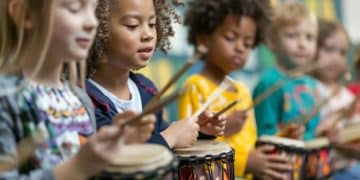Music Education’s Impact on Cognitive Development in Young Children

Music education significantly enhances cognitive development in young children by fostering neural connections, improving executive functions, and stimulating linguistic, mathematical, and emotional intelligence, providing a holistic foundation for lifelong learning and well-being.
Delving into the profound ways how does music education impact cognitive development? Exploring the benefits for young children reveals a fascinating intersection of art and neuroscience. As children embark on their developmental journeys, opportunities that stimulate their minds in multifaceted ways become paramount. Music, an ancient and universal language, presents one such powerful avenue for growth beyond mere artistic expression.
The Neuroscientific Foundations of Music and Brain Development
The intricate relationship between music and the developing brain is a subject of increasing scientific interest. Research consistently indicates that engaging with music from an early age can profoundly influence neural architecture, laying down crucial pathways that support a wide array of cognitive functions. This isn’t merely about appreciating melodies; it’s about active engagement that shapes the very fabric of the brain.
From the moment a child first listens to a lullaby, their brain begins to process auditory information in complex ways. As they grow and actively participate in music – singing, clapping, playing instruments – different brain regions are activated simultaneously. This multi-sensory experience helps to forge stronger, more efficient neural connections, particularly in areas related to language, memory, and spatial reasoning.
Auditory Processing and Sensory Integration
Music education sharpens auditory processing abilities, which are foundational for many learning tasks. Children learn to discern pitch, rhythm, timbre, and dynamics, skills that transfer to other areas. This enhanced auditory discrimination supports language acquisition and phonetic awareness, critical components of reading readiness.
- Improved ability to distinguish subtle sound differences.
- Enhanced phonological awareness, aiding in language and literacy.
- Strengthened connections between auditory and motor cortices through rhythmic activities.
The process of internalizing and producing music requires the brain to integrate various sensory inputs. A child striking a drum not only hears the sound but also feels the vibration, sees the movement, and coordinates their motor skills. This comprehensive sensory integration fosters denser neural networks, improving overall brain efficiency.
Brain Plasticity and Synaptic Growth
Young brains exhibit remarkable plasticity, meaning their structure can change and adapt in response to experience. Music education provides a rich, complex environment that actively promotes this plasticity. Regular musical engagement stimulates synaptic growth, essentially creating more communication channels between neurons.
Studies using neuroimaging have shown that musicians, even young ones, often have larger grey matter volumes in certain brain regions, such as the auditory cortex and motor cortex. This structural enhancement is directly linked to the demands of musical training, reinforcing the idea that specific experiences can physically reshape the brain. The earlier these experiences begin, the more pronounced their long-term effects can be.
Enhancing Executive Functions through Musical Engagement
Executive functions are a set of cognitive processes that control and regulate other abilities and behaviors. These include working memory, inhibitory control, and cognitive flexibility – all critical for academic success and life skills. Music education provides a unique and engaging platform for the development and refinement of these vital functions.
When children learn music, they are constantly engaging their executive functions. Whether it’s remembering a sequence of notes, resisting the urge to play too fast, or adapting to changes in tempo, music demands a high level of self-regulation and mental agility. This consistent practice translates into improvements across various cognitive domains.

Working Memory and Attention
Playing an instrument or singing in a choir requires children to hold multiple pieces of information in their minds simultaneously: the melody, the rhythm, the lyrics, and often, instructions from a teacher. This continuous exercise in juggling information strengthens working memory, making children better at retaining and manipulating data for short periods.
- Memorizing melodies, lyrics, and rhythmic patterns.
- Paying sustained attention to musical cues and instructions.
- Integrating new information with previously learned material.
Furthermore, music demands focused attention. Children must concentrate on their own performance while also listening to others, ensuring they stay in sync. This structured attentional practice helps them develop better selective attention and sustained attention, invaluable skills for classroom learning and everyday tasks.
Inhibitory Control and Cognitive Flexibility
Inhibitory control, the ability to resist impulsive actions or distractions, is significantly bolstered by music education. For instance, a child learning an instrument must inhibit the urge to play the wrong note or stop when the music requires a pause. This self-control is key to mastering musical pieces and extends to other areas of their lives, such as impulse regulation in social settings.
Cognitive flexibility, or the ability to switch between different concepts or tasks, is another executive function benefit. Musicians often need to change instrumentation, adapt to new time signatures, or improvise, all of which require a flexible mindset. This constant mental shifting fosters adaptability and problem-solving skills, preparing children to navigate complex situations more effectively.
Fostering Linguistic and Mathematical Skills
At first glance, music might seem far removed from subjects like language and math. However, a deeper look reveals a profound interconnectedness. Music education inherently weaves in principles that underpin both linguistic and mathematical reasoning, making it a powerful, multisensory tool for reinforcing these critical academic foundations.
The structured nature of music, with its patterns, rhythms, and pitch relationships, mirrors the fundamental organization found in language and mathematics. By engaging with these musical structures, children implicitly develop a stronger grasp of abstract concepts and logical thinking, which are transferable to these academic domains.
Rhythm and Phonemic Awareness in Language
The rhythmic complexity of music directly translates to an enhanced understanding of language structure. Just as music has a beat and meter, language has natural rhythms and stresses. Children who engage with music often develop a heightened awareness of phonemes (the smallest units of sound) and syllables, which are crucial for early literacy and reading development.
Singing songs, especially those with repetitive lyrics and clear rhythmic patterns, helps children segment words into individual sounds and blend them back together. This phonemic awareness is a strong predictor of reading success. Moreover, learning to differentiate between different pitches and timbres in music can improve a child’s ability to discriminate between similar-sounding words, reducing comprehension errors.
Patterns and Proportions in Mathematics
Music is fundamentally mathematical. Concepts such as rhythm (pulses, durations), harmony (intervals, chords, ratios), and form (patterns, repetition, variation) are deeply rooted in mathematical principles. When children learn about quarter notes, half notes, or eighth notes, they are implicitly engaging with fractions and proportional reasoning.
- Identifying and creating rhythmic patterns introduces basic algebraic thinking.
- Understanding musical intervals relates to mathematical ratios and proportions.
- Recognizing musical scales and structures enhances pattern recognition.
The structured, sequential nature of music, where notes follow specific rules and relationships, helps children develop logical thinking and problem-solving skills. They learn to identify patterns, predict outcomes, and understand the relationships between different elements, all of which are core mathematical competencies.
Cultivating Creativity and Emotional Intelligence
Beyond the purely cognitive benefits, music education is also a powerful catalyst for developing essential socio-emotional skills. It offers a unique space for self-expression, fostering creativity, empathy, and emotional regulation in ways that traditional academic subjects rarely can. These non-cognitive skills are increasingly recognized as vital for overall well-being and success in adulthood.
Music provides a safe and engaging outlet for children to explore their feelings and understand the emotions of others. Whether through active participation or passive listening, music shapes their emotional landscape and offers tools for navigating the complexities of human experience.
Self-Expression and Innovation
Music is a universal language of emotion and a profound medium for self-expression. Through singing, playing instruments, or composing, children find unique ways to communicate their inner worlds. This creative outlet encourages them to take risks, experiment with sounds, and develop their own artistic voice, fostering a sense of originality and innovation.

When children are encouraged to improvise or create their own melodies, they are engaging in divergent thinking – exploring multiple solutions to an open-ended problem. This process of creative problem-solving is not limited to music; it translates into an ability to think outside the box in other academic and life contexts.
Empathy and Emotional Regulation
Music has a remarkable capacity to evoke and communicate emotions. By listening to different genres and pieces, children learn to identify and interpret various emotional states expressed through sound. This exposure cultivates empathy, as they begin to understand how music can reflect and influence feelings, both their own and others’.
- Recognizing and interpreting emotions conveyed through music.
- Developing emotional vocabulary through musical expression.
- Using music as a tool for self-soothing and emotional regulation.
Furthermore, music can be a powerful tool for emotional regulation. Calming melodies can help soothe an agitated child, while upbeat tunes can lift spirits. Learning to use music intentionally for mood management provides children with a valuable coping mechanism and a deeper understanding of their own emotional landscape.
Social Skills and Cultural Understanding
Music education, particularly in group settings, naturally cultivates a range of essential social skills. Collaborative music-making requires cooperation, communication, and mutual respect, attributes that are critical for successful interactions in all aspects of life. It also serves as a vibrant bridge to understanding diverse cultures and traditions.
Beyond individual development, music fosters a sense of community and belonging. When children sing or play together, they learn to synchronize their actions, listen to each other, and contribute to a shared goal, reinforcing the importance of teamwork.
Collaboration and Communication
In music ensembles or group classes, children learn the art of collaboration. Each child has a role to play, and the success of the group depends on every member contributing effectively. They learn to listen actively to their peers, adjust their performance to fit the group, and communicate non-verbally through shared musical cues.
This collaborative experience teaches patience, compromise, and the value of collective effort. It also provides opportunities for children to lead and follow, depending on the musical context, thus developing versatile social leadership skills essential for navigating group dynamics.
Cultural Awareness and Appreciation
Music is inextricably linked to culture. By exploring music from different parts of the world, children gain exposure to diverse traditions, historical contexts, and artistic expressions. This not only broadens their worldview but also instills a sense of respect and appreciation for the richness of global human experience.
- Exposure to diverse musical genres and instruments from around the world.
- Understanding the cultural significance and historical context of music.
- Developing an open-minded perspective towards different traditions.
Learning songs in different languages or understanding the stories behind traditional melodies can spark curiosity about other cultures, promoting a more inclusive and empathetic understanding of the world. Music thus becomes a powerful vehicle for fostering global citizenship from an early age.
Practical Implementation: Integrating Music into Daily Life
Understanding the profound benefits of music education is one thing; effectively integrating it into a young child’s daily life is another. It doesn’t necessarily require formal lessons or expensive instruments, especially in the early years. Simple, consistent exposure and engagement can yield significant developmental advantages, laying a robust foundation for future learning.
The key is to make music a natural, enjoyable, and accessible part of their environment. This can occur in various settings, from the home to structured classroom environments, and should prioritize active participation over passive consumption.
At Home: Creating a Musical Environment
Parents play a crucial role in fostering a child’s early musical development. Simple activities like singing lullabies, playing music during playtime, or even just dancing together can create a rich musical environment. Providing access to age-appropriate musical toys like shakers, drums, or toy keyboards encourages exploratory play.
Establishing a routine that includes music, such as a “music time” where children can listen, sing, or move freely, can normalize musical engagement. Limiting screen time and replacing it with interactive musical activities also contributes to more active and beneficial engagement.
- Singing songs and nursery rhymes daily.
- Dancing and moving to various types of music.
- Providing simple, child-friendly musical instruments.
It’s also beneficial to expose children to a diverse range of musical genres, from classical to jazz, folk, and world music. This broad exposure helps develop their auditory palette and appreciation for different sounds and structures.
In Educational Settings: Formal and Informal Approaches
Many preschools and early childhood programs now incorporate music education into their curriculum, recognizing its developmental impact. These settings often provide structured activities that build foundational musical skills while integrating them with other learning objectives.
Formal music classes, such as Kindermusik or early Suzuki programs, offer structured learning paths under the guidance of trained instructors. These programs focus on concepts like rhythm, pitch, and ensemble playing, fostering discipline and advanced musical skills while reinforcing cognitive benefits. However, even informal approaches, such as incorporating songs into learning letters or numbers, can be highly effective.
Ultimately, the method of implementation is less important than the consistent availability of musical experiences. By providing varied and engaging musical opportunities, educators and parents can help unlock a child’s full cognitive potential.
| Key Benefit | Brief Description |
|---|---|
| 🧠 Cognitive Enhancement | Boosts brain plasticity, working memory, and attention. |
| 🗣️ Language & Math Skills | Improves phonemic awareness and understanding of patterns. |
| ❤️ Emotional & Social Growth | Fosters emotional regulation, empathy, and collaboration. |
| 🎨 Creativity & Expression | Encourages self-expression, innovative thinking, and cultural appreciation. |
Frequently Asked Questions About Music Education and Cognitive Development
While benefits exist at all ages, early childhood (from infancy to around age seven) is particularly crucial due to rapid brain development and high neural plasticity. Engaging with music during this period can establish strong foundational pathways for lifelong learning and cognitive advantages, making early exposure highly impactful.
While passive listening can offer some benefits, such as mood regulation and auditory stimulation, active participation (singing, playing instruments, dancing) provides significantly more profound cognitive benefits. Active engagement requires more complex neural processing, fostering executive functions, fine motor skills, and multisensory integration more effectively.
Research suggests that any active musical engagement is beneficial. However, instruments or vocal training that require precise pitch discrimination, rhythmic coordination, and fine motor control (like piano, violin, or voice) may offer more comprehensive cognitive boosts. Exposure to diverse genres is also vital for broad cognitive stimulation.
Music education indirectly enhances academic performance by improving executive functions such as working memory, attention, and problem-solving skills crucial for subjects like math and reading. It also strengthens linguistic processing and pattern recognition, directly supporting early literacy and numerical comprehension, contributing to overall academic readiness and success.
Absolutely. The cognitive and socio-emotional benefits of music education are universal and do not depend on innate musical talent. The goal isn’t to create a prodigy, but to leverage music as a powerful tool for holistic development. Consistent exposure and encouragement, regardless of perceived talent, offer significant developmental advantages for every child.
Conclusion
The journey to understand how music education impacts cognitive development reveals a compelling narrative of brain plasticity and multifaceted growth. Far from being a mere extracurricular activity, engaging young children in music provides a powerful, holistic pathway to intellectual, emotional, and social flourishing. From sharpening executive functions and bolstering linguistic and mathematical skills to cultivating creativity and empathy, music education offers a rich tapestry of developmental advantages.
For parents, educators, and policymakers, recognizing and actively investing in music education is not just about nurturing future artists; it’s about fostering more adaptable, intelligent, and well-rounded individuals ready to navigate the complexities of the modern world. The harmony forged through early musical experiences truly resonates through a child’s entire developmental trajectory, leaving a lasting, positive imprint on their cognitive architecture and overall well-being. By embracing music, we empower the next generation to think more creatively, connect more deeply, and learn more effectively.





